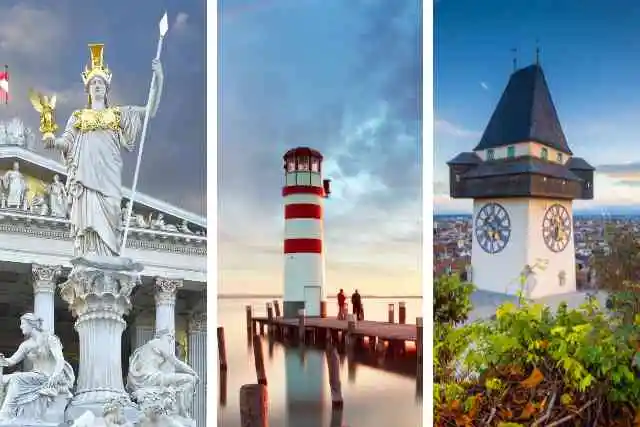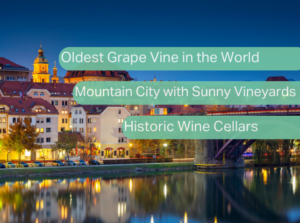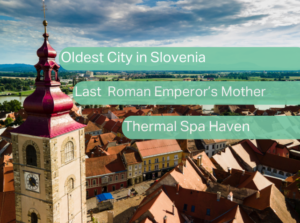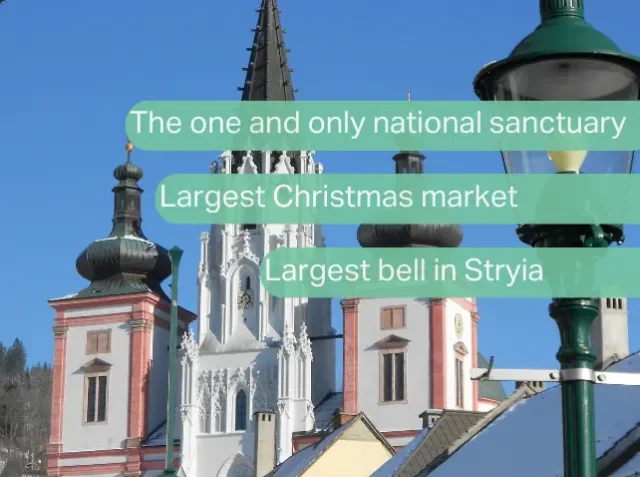Gmunden, at the foot of the Alps, is home to the Traunsee lake and Traun River. Its coat of arms, dating back to 1593, features salt, transport, fishing, nature, and mountains. The deep Traunsee is perfect for water sports and hiking. Gmunden has a fascinating history, evolving from early fishermen, medieval fortifications, and 17th-century Bavarian struggles to become a resort town. It’s known for Gmundner Keramik ceramics, Cumberland and Weyer Castles, the Parochial Church, the Sanitary Museum Klo & So, the steamer Gisela, and the Gmunden Tramway.

Gmunden is a picturesque little town in the Salzkammergut region, nestled on the shores of the beautiful Traunsee lake. Situated at the foot of the Alps, Gmunden’s beautiful setting has made it a popular summer resort. The Traunstein mountain, which rises to 1681 metres, attracts walkers and climbers. Because of its unique location, Gmunden is known as the gateway to the Salzkammergut.
Gmunden Name
The city of Gmunden gets its name from the German “bei den Mündungen,” which means “near the mouth.” It was named this way because the Traun River flows into the Traunsee.
Highlights of Gmunden
- Schloss Ort – This medieval castle on an island in Lake Traunsee, first mentioned in 909 AD, became well-known from the Austrian TV series “Schlosshotel Orth.”
- Traunsee Lake – The deepest lake in Austria, reaching depths of up to 191 meters, is central to Gmunden’s identity and perfect for boating, swimming, and enjoying scenic views.
- Gmundner Keramik (UNESCO) – Founded in 1492, this ceramics factory is famous for its green-flamed pottery. Visitors can tour the factory, learn about pottery-making, and purchase unique ceramics.
- Rathaus (Town Hall) – Built in the 16th century, the Town Hall features a unique ceramic façade by Gmundner Keramik and serves as the administrative center of Gmunden, showcasing the town’s ceramic heritage.
- Traunstein Mountain – Known as the “Guardian of the Salzkammergut,” this mountain rises to 1,691 meters and is popular for hiking and climbing, offering challenging trails and stunning vistas.
Coat of Arms

The coat of arms of Gmunden was granted in 1593 by Emperor Rudolf II. It features several symbols representing different aspects of the town:
- Three Buckets: Symbolize the salt industry.
- Boat: Represents transport.
- Fish: Refers to the fishing industry.
- Leaves: Signify the town’s closeness to nature.
- Mountain: Represents the mountainous location of Gmunden.
Support
Support Austria by Oeffis and help us share Vienna’s magic with the world. Your contribution makes a difference!
Traunsee
Traunsee, the deepest lake in Austria, is a stunning natural gem located in the Salzkammergut region of Upper Austria. Positioned at 423 meters above sea level, this lake stretches 11.9 km in length and 2.9 km in width, with a maximum depth of 191 meters. The lake receives water from the Traun River and other smaller streams, eventually draining back into the Traun River.
The picturesque towns of Gmunden, Ebensee, Altmünster, and Traunkirchen grace its shores, each offering unique cultural and recreational experiences. Surrounded by the Northern Limestone Alps, including the imposing Traunstein mountain, Traunsee is the fourth largest lake in Austria, covering an area of 24.35 square kilometers. This lake is a popular destination for water sports, hiking, and enjoying breathtaking alpine scenery.

The town, located in the Salzkammergut, can be considered relatively expensive. We recommend eating outside the centre, for example in the Brauhaus restaurant, which has 4.6 stars on Google Maps, serves traditional food and has affordable prices.
We encourage you to take a walk along the lake, walk in the forests
The Traunsee Name
The Romans who settled in the vicinity of Gumnden called the lake “lacus felix” (happy lake), because of the beautiful landscape.

What is Salzkammergut?
Salzkammergut is a stunning cultural region in Austria, spanning Upper Austria, Salzburg, and Styria. Known for picturesque lakes like Traunsee, Fuschlsee, and Wolfgangsee, and scenic mountains, its beauty and rich heritage make it a popular tourist destination.
Gmundner Keramik
Gmundner Keramik is a renowned Austrian ceramic brand produced by the Gmundner Keramik Manufaktur in Gmunden. This makes Gmunden one of the most important places in Europe for creating ceramics. Archaeological finds show that ceramics have been produced in this region since the Stone Age, but it gained significant importance and popularity in the Middle Ages. The unique ceramics and their production process from Gmunden have been inscribed on the UNESCO World Heritage List.
The brand’s historical significance is evident through extensive collections in institutions like the MAK Vienna and the Upper Austrian State Museum, as well as through international art auctions. Gmundner Keramik continues to produce all pieces in Austria, from raw material preparation to hand-painting each item using traditional techniques. Visitors can explore the production process at the Gmunden facility, with flagship stores in Salzburg and Hallstatt.

Subscribe to our newsletter for exclusive travel tips, event updates, special offers, historical insights, gourmet recommendations, travel deals, personalized content, interactive guides, photo highlights, and community connections. Enhance your Austrian adventures and never miss out on the best experiences. Join us now!
Early History
The first permanent settlers in Gmunden were fishermen around the 5th century AD, likely building houses on stilts in the lake. During Roman times, Gmunden became an attractive location where residents of cities like Salzburg bought estates and built villas on the shores of Lake Traunsee. After the fall of the Roman Empire, Bavarians settled in the area.

Medieval Period
By 1188, Gmunden transformed into a fortified town with seven towers, walls eight meters high, and two meters wide. In 1217, the first court was established, along with a pillory in the market square. In 1300, the town received its first church. Despite gradual decline over the centuries, Gmunden remained significant due to its proximity to Salzkammergut’s salt mines, becoming a transshipment point for salt and a site for building war boats from the 16th century onward.

17th Century Struggles
In the 17th century, Gmunden faced hardships under Bavarian occupation. Prince Maximilian of Bavaria imposed strict and unfair rules on Lutheran citizens. A peasant uprising in 1626 temporarily disrupted Bavarian control, leading to chaos, market emptiness, and looting. Peace returned in September 1626, but musketeers caused more destruction until General Pappenheim’s forces defeated the peasants in November 1626. Gmunden remained under Bavarian rule until 1628.

Population Control
Due to its popularity, a decree in 1654 stopped people from moving to the Salzkammergut region. This ban was reaffirmed by a court order in 1700 to prevent overcrowding. Gmunden remained under special protection until the reign of Joseph II, who allowed more settlement in the area.
Resort Town Development
With the decline of salt mining, Gmunden began to gain popularity as a resort town, officially earning this title in 1862.

World War I
During World War I, Gmunden became a hub for caring for injured soldiers. The war’s impact led to an increase in diseases, prompting the establishment of sanatoriums.
World War II and Nazi Period
During the National Socialist period, citizens of Gmunden could not shop in Jewish stores, and those who did were shamed in local newspapers. Brave locals distributed anti-Nazi propaganda, risking being sent to concentration camps. Fortunately, Gmunden escaped direct damage during World War II and again served as a treatment center for soldiers. After the war, Gmunden was in the American occupation zone. The Americans set up a spy center using local knowledge of the area and Russian control methods.
Although the town faced many challenges, the bravery of its people stands out. While the prohibition on shopping in Jewish stores created a climate of fear, some residents still chose to resist. Moreover, after the war, the American presence brought a new dynamic to the town. By setting up a spy center, the Americans utilized the locals’ knowledge, blending it with their strategic needs. Therefore, Gmunden’s history during this period reflects both resilience and adaptability.
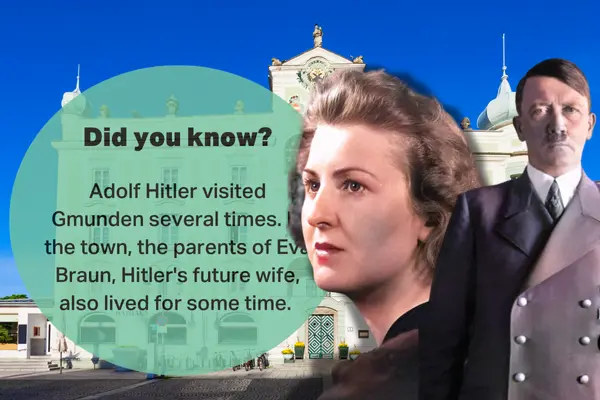
See in Gmunden
Cumberland Castle
Cumberland Castle, built between 1882 and 1886, stands northeast of Gmunden near Lake Traunsee. Designed by Ferdinand Schorbach in a Tudor-Gothic style, it served as a residence for the Guelph family and was constructed from red marble, granite, and sandstone. The castle housed many treasures, including the famous Guelph Bible, a masterpiece of Romanesque book illumination from the 12th century. After WWII, it became a sanatorium and later a state care facility. The mausoleum holds the remains of Hanoverian royals, including Queen Marie. Today, the castle occasionally opens for tours and serves as a filming location, preserving its historical charm and grandeur.

Weyer Castle
Weyer Castle, located in Gmunden near Lake Traunsee, dates back to 1446. Built in 1596 by Abraham von Rorbach, it has changed hands many times. In the 19th century, it served as a boys’ orphanage and later a school.
Now owned by Otto Schober, the castle underwent renovations starting in 1981. It features a baroque chapel with a 1696 altar, a vaulted ceiling, and an old well in the courtyard. The L-shaped building has sgraffito decorations. Today, it houses a gallery for Meissen porcelain and silverware. Occasionally, the courtyard and chapel are open for special events.
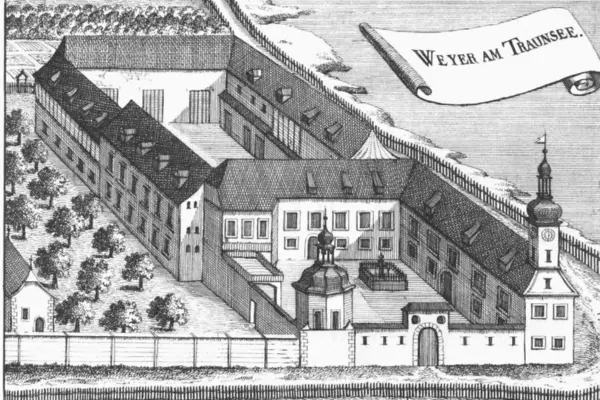
Parochial Church
The Roman Catholic parochial church, dedicated to the Virgin Mary and the Three Kings, is located in the Salzkammergut region of Upper Austria. It belongs to the Gmunden deanery in the Linz diocese and is housed in a historic building. The church, facing east, stands on a hill near the northern shore of Lake Traunsee, only 200 meters from the Traun River. First mentioned in 1270, the church dominates the town’s landscape, growing alongside the town, which thrived due to salt mining and trade. Medieval, Renaissance, and Baroque buildings testify to the town’s prosperity. The church’s interior features significant artworks, including a life-sized Adoration of the Magi by Thomas Schwanthaler, side altar figures by Michael Zürn the Elder, and later additions like the Fatima Madonna by Klothilde Rauch.

Sanitary Museum in Kammerhof
The Sanitary Museum Klo & So, opened in 1988, showcases a unique collection of 300 historical sanitary objects, including toilets, sinks, and bathtubs, on permanent loan from Laufen Austria AG and its former director, Fritz Lischka. Located on the top floor of the K-Hof Kammerhof Museums, the museum is part of a larger exhibition space that opened in 2008, covering over 2000 m². The museum provides a cultural and historical perspective on the evolution of sanitary ceramics and hygiene standards, featuring neobaroque sanitary ware, painted toilet bowls, and a patented siphon toilet from around 1900. Situated in the historic Kammerhof, originally a toll and salt office at the mouth of the Traun River, the museum continues to attract visitors with its intriguing displays and historical significance.
The Kammerhof in Gmunden, originally built in the 14th century, became the central administrative hub for the salt industry in the Salzkammergut region from 1453. This complex, initially Gothic, expanded over the centuries, with significant additions like the lake-side wing in 1854. Serving as the seat of the princely salt office, it managed salt production and trade, a crucial economic activity that enriched the Habsburg monarchy. Notable figures, including Emperor Frederick III and Emperor Maximilian I, visited to oversee salt affairs. The Kammerhof also housed the Salzamtmann’s residence, making it a social and cultural center with theatrical performances and concerts. During the Nazi era, the Kammerhof became a museum, preserving the town’s history. The Kammerhof Museum now showcases the region’s rich heritage. Post World War I, the building served various purposes, including housing and shops. In the 1960s, a major renovation transformed it into a cultural venue with banquet halls and galleries. Today, the Kammerhof remains a testament to Gmunden’s historical significance and cultural evolution.
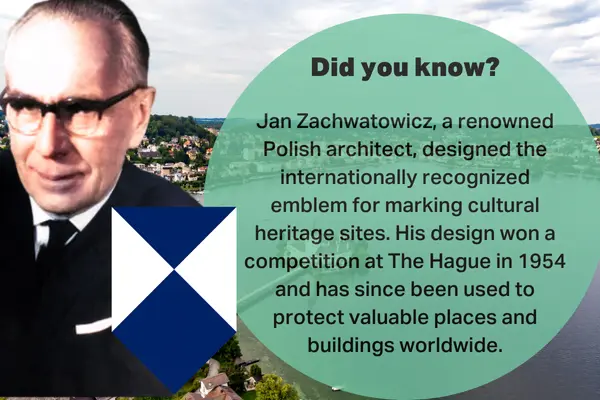
The Gisela
The Gisela, a historic rowing steamer with a riveted steel hull, was built in 1871 by Joseph John Ruston and commissioned in 1872 on Lake Traunsee. Named after the eldest daughter of Emperor Franz Joseph I, Gisela served tourists, especially after the opening of the Kronprinz Rudolf Railway in 1877. During World War I, Rudolf Ippisch took over the ship. In 1938, a new boiler was installed. Despite being decommissioned in 1975, the ship returned to service after an overhaul in 1976.
Today, Traunseeschifffahrt Karlheinz Eder GmbH operates the Gisela from May to October. The ship carries up to 250 passengers, preserving its historical significance and connecting the past with the present.

Gmunden Tramway
Only five urban tram networks exist in Austria today. It’s quite extraordinary that a small town like Gmunden offers this mode of transport regularly to both its residents and visitors! The Gmunden Tramway, opened on 13 August 1894 as the Gmunden Electric Local Railway (ELBG), is a metro tram line in Upper Austria. With a length of 2.315 km and a track width of 1000 mm, the line is considered the smallest tram in the world. Additionally, it is one of the steepest trailer railways with a maximum gradient of 10%.
In 1946, the tram set a record with 736,898 passengers, a number that still stands today. Since 1975, it has carried more than 300,000 passengers a year. Traunseeschifffahrt Karlheinz Eder GmbH owns and operates the tram. In 2018, the tram combined with the Traunseebahn to form the “Traunseetram,” enabling direct travel between Gmunden and Vorchdorf. This tram, a historical and tourist symbol, has undergone many modernizations while maintaining its unique character.
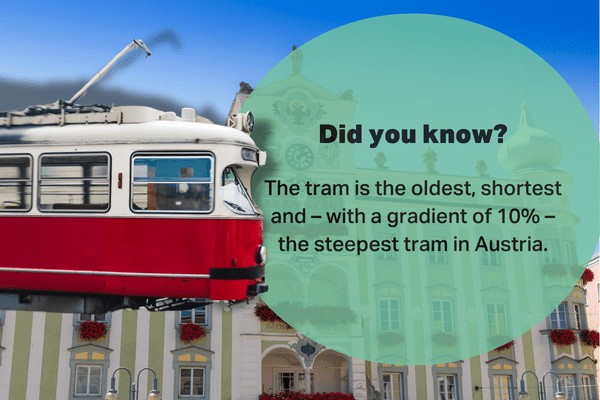
Traunstein
Traunstein, at 1691 meters above sea level, is a prominent landmark in Upper Austria’s Salzkammergut region. Known for its steep rock faces and scenic views, it’s a favorite among hikers and climbers. The area is home to diverse flora and fauna, protected since 1963. Notable peaks like Fahnenkogel and Pyramidenkogel can be reached via several marked trails. The western wall, descending 1000 meters to Lake Traunsee, dominates the landscape. The mountain also features rare plant species and is rich in wildlife, including chamois and alpine choughs.
Legend
According to legend, a wagon driver with a heavy load tried to cross the Traun River one day. The wagon became stuck in the middle of the river and couldn’t move any further. Frustrated, the driver shouted, “I wish everything would turn to stone!” Miraculously, at that very moment, church bells in Haslach rang for prayer, and suddenly the wagon, horses, and driver turned into a massive stone. Today, you can still see the remains of this stone, known as Traunstein, at that spot.
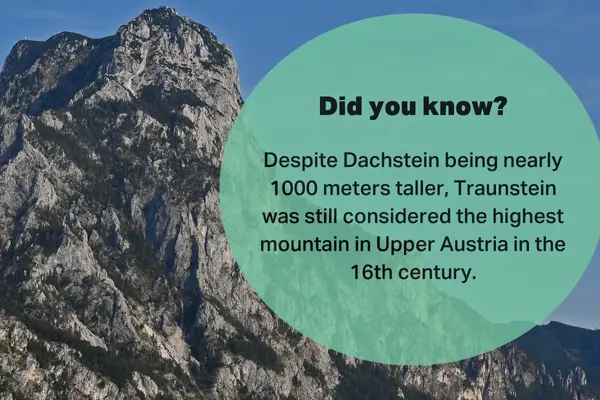
Ort Castle
Ort Castle, also known as Schloss Ort, consists of two castles on Lake Traunsee: Seeschloss Ort on an island and Landschloss Ort connected by a bridge. The castle takes its name from one of its earliest noble families, the Herren von Ort, who ruled the castle. Seeschloss Ort, one of the oldest buildings in the Salzkammergut region, first appeared in documents in 909 AD. After a fire in 1626, it was reconstructed in its current form. The castle served various feudal lords until Emperor Frederick III bought it in 1483, followed by Emperor Rudolf II in 1603. The Landschloss Ort, built in 1634, has served various purposes over the centuries, including as a military hospital and a forestry training center. Today, it hosts events and a restaurant, attracting numerous visitors.
Legend
The giant Erla fell in love with a nymph he saw bathing in Laudachsee. He asked the witch Kranawitha to give him a human form and legs for the nymph, whom he called Blondie. He built an island on Traunsee and a magnificent castle, where their wedding took place. However, after a year, Blondie grew weaker and died. Erla placed her in a glass coffin and sank it in the lake. In his grief, he carved her face into a rock, which can still be seen today.

Gmunden Town Hall
The Gmunden Town Hall, built mainly in the 16th century, is one of the city’s most beautiful buildings. Its 18th-century stucco façade is richly decorated. This unique town hall, set on the lake’s edge, has beautiful loggias and detailed decorations. You can also listen to the charming carillon made of porcelain and ceramics, which plays famous tunes several times a day.
Gmunden, famous worldwide for its porcelain, decided to honor this heritage by installing a ceramic carillon on the town hall wall. However, the local ceramics were too coarse for this purpose. So, they chose to use Meissen porcelain instead. The inaugural ceremony for the carillon took place in 1958.
Summer: 10:00, 12:00, 13:00, 14:00, 15:00, 16:00, 17:00, and 19:00.
Advent season: 10:00, 12:00, 14:00, 16:00, 17:00, and 18:00.
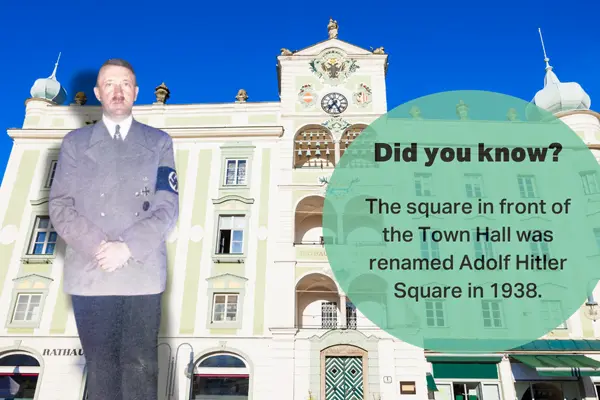
Treetop Walk Salzkammergut
The Salzkammergut treetop walk, open from March to mid-November, is a new attraction. The 1400-meter-long route leads through the Grünberg Forests, ending at the 39-meter-high lookout tower for a fantastic view. The tower, resembling a barrel of salt, is made of wood. For those who do not want to return on foot, a 75-meter slide is available as an alternative method of descent.
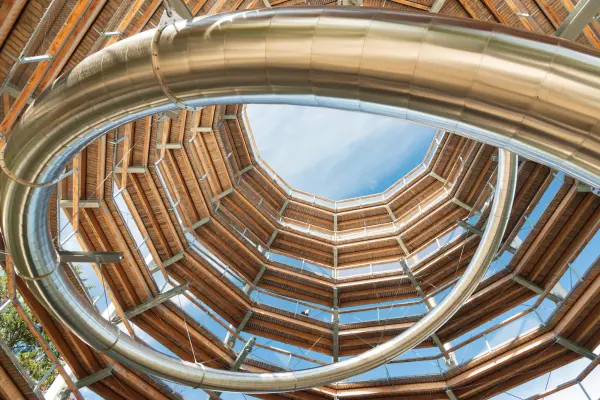
Bürgerspitalkirche
The Church of the Civic Hospital, built around 1340 and dedicated to St. Jakob, formed part of a foundation established to care for the poor, the sick, orphans, and widows. In 1623, workers added an onion-shaped dome. In 1899, they transformed it into a pointed tower. After the social hospital closed in 1789, the city took control of the church. Inside, it displays statues of saints and apostles and features the Way of the Cross with 12 Stations. The church has undergone several renovations over the years. It now connects to the Kammerhof building, enhancing its historical and architectural significance.

Jewish Cemetery
The Jewish cemetery opened in 1923 and faced destruction in 1938. After World War II, the community rebuilt it, and now it is well-maintained. The Jewish community in Linz initially owned the cemetery. They created it to serve the local community, which faced difficulties transporting the deceased to Linz. About twenty burials took place in the new cemetery until 1938. However, after the Nazis came to power, they destroyed the cemetery. Later, the community rebuilt it after the war.
Although the cemetery faced many challenges, it now stands as a symbol of resilience and history. While it initially struggled to serve the community, its reconstruction shows the enduring spirit of the people. Therefore, the well-maintained state of the cemetery today honors those who worked hard to restore it.

Villa Toscana
Villa Toscana, built in the 19th century, sits in a large park and forms a significant architectural ensemble with the Little Villa Toscana and Toscana Park. Located on a peninsula near Ort Castle and the Toscana Congress conference center, the villa was constructed between 1870 and 1877. It served as a summer residence for Marie Antoinette of Naples-Sicily. Later, architect Rudolf Perco rebuilt it, transforming it into a meeting and seminar place. Toscana Park covers 88,000 m² and enjoys protection as a historical monument. The park features beautiful old trees and a formal landscape layout, which adds to its charm and historical significance.



